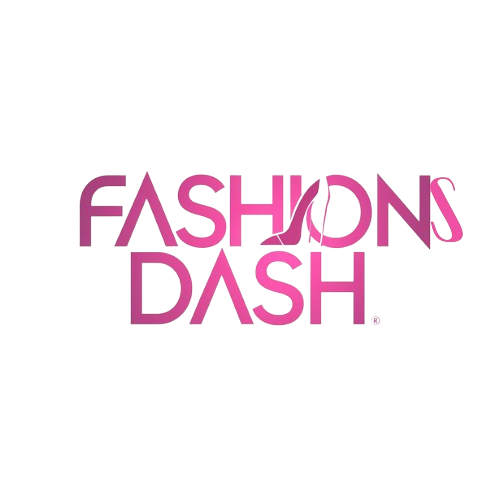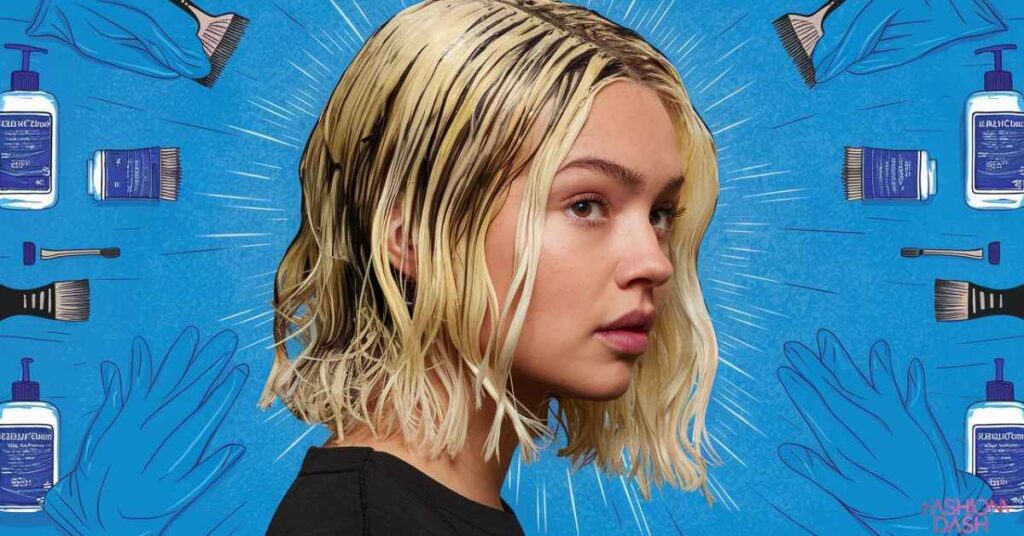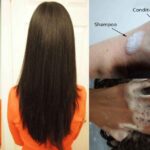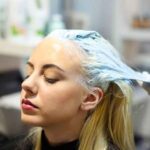Are you dreaming of sun-kissed blonde locks or an icy platinum hue? Bleaching your hair is a bold move that can completely transform your look. But one question often arises: can you bleach hair wet or damp? The short answer is yes, but there are some important caveats to consider.
In this comprehensive guide, we’ll explore the difference between bleaching wet versus dry hair, the proper preparation, and aftercare tips. Plus, we’ll dive into situations where bleaching damp hair may actually be preferred.
Get ready for an in-depth look at achieving stunning, vibrant results while keeping your strands healthy and strong.
The Difference Between Bleaching Dry vs Wet Hair
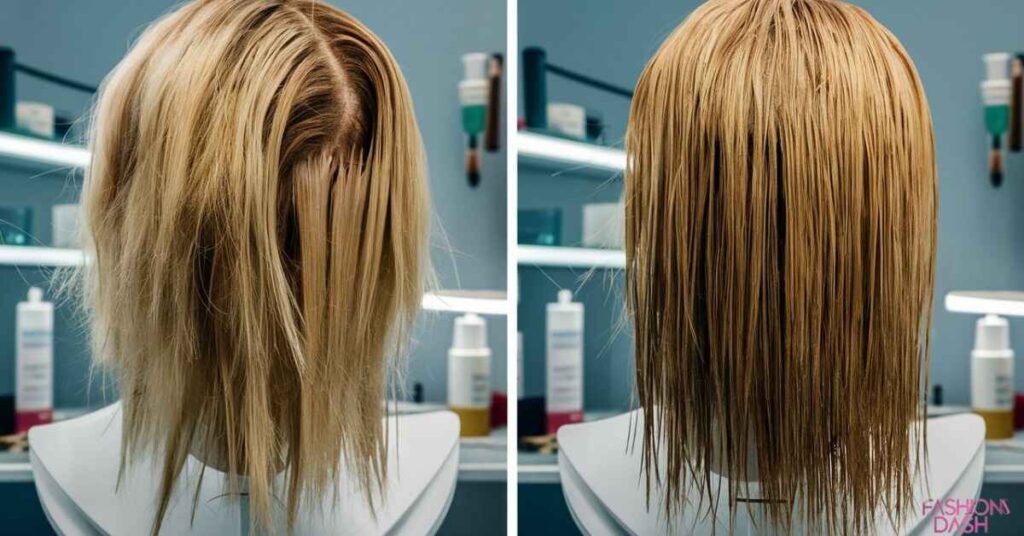
When it comes to bleaching, the moisture level of your hair plays a crucial role. Let’s break down the key differences between bleaching dry and wet strands.
Bleaching Damp Hair
Bleaching damp or wet hair can be a bit riskier than working on dry locks. Here are some potential drawbacks.
- Uneven Coverage: Water can dilute the bleach mixture, leading to patchy, uneven coverage.
- Increased Porosity: Wet hair is more porous, which means the harsh bleaching chemicals can penetrate deeper, potentially causing excessive damage.
- Reduced Efficacy: The diluted bleach may not work as effectively, requiring multiple applications or longer processing times.
However, there are certain techniques where bleaching damp hair can be advantageous. For example, balayage highlights or root touch-ups may be easier to apply and blend on slightly damp strands.
Read This Blog: SHOULD I WASH MY HAIR BEFORE A HAIRCUT
Bleaching Dry Hair
On the other hand, bleaching dry hair is generally considered the safest approach. Here are some benefits.
- Even Application: Dry hair allows for precise, even saturation of the bleach mixture, minimizing the risk of missed spots or uneven tones.
- Better Control: Without moisture interference, you have more control over the bleaching process, making it easier to achieve your desired level of lift.
- Reduced Damage: Dry hair is less porous, which means the bleach won’t penetrate as deeply, potentially causing less damage.
To ensure optimal results, most professional stylists recommend bleaching hair that is clean, dry, and free of any product buildup.
Preparing to Dye Your Hair
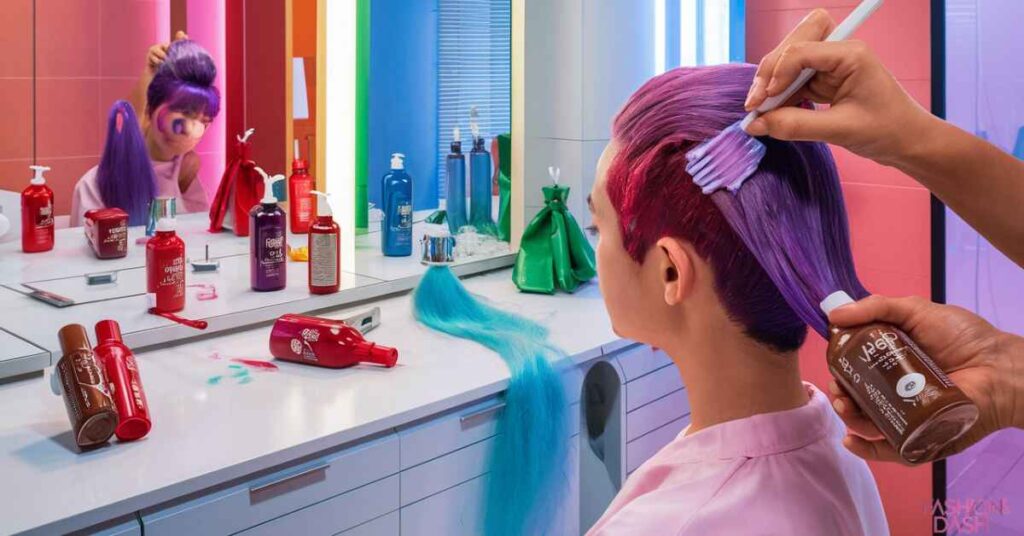
Before you embark on your bleaching journey, proper preparation is key. Here are some essential steps to follow.
Also Read This Blog: WHAT COLOR SHOES TO WEAR WITH BROWN DRESS
- Patch Test: Always perform a patch test 48 hours before bleaching to check for any potential allergic reactions.
- Deep Condition: A few days before your bleaching session, use a deep conditioning treatment to fortify and nourish your strands.
- Sectioning: Divide your hair into manageable sections and clip them out of the way. This ensures even saturation and prevents missed spots.
- Use Protection: Apply a petroleum-based barrier cream (like Vaseline) around your hairline, ears, and neck to protect your skin from the harsh chemicals.
- Mix Carefully: Follow the product instructions precisely when mixing the bleach powder and developer. Using the wrong ratio can lead to ineffective or damaging results.
- Work in Sections: Apply the bleach mixture to one section at a time, starting from the back and working your way forward. This allows for better control and even distribution.
- Time It Right: Closely monitor the processing time recommended by the product manufacturer. Over-processing can lead to excessive damage and breakage.
- Rinse Thoroughly: Once the desired level of lift is achieved, rinse the bleach out completely with cool water. Avoid shampooing immediately after to prevent further damage.
Remember, bleaching is a chemical process that can be harsh on your hair. It’s always best to consult a professional stylist, especially if you’re attempting a dramatic color change or have previously treated hair.
After-Care for Dyed Hair
After the bleaching process, your hair will be in a fragile state. Proper aftercare is crucial to maintain the health and vibrancy of your new hue. Here are some essential tips.
- Use a Bond Rebuilder: These specialized treatments help repair and strengthen the compromised bonds in your hair, minimizing damage and breakage.
- Deep Condition Regularly: Incorporate weekly deep conditioning treatments to replenish moisture and nourish your strands.
- Adjust Your Haircare Routine: Switch to a sulfate-free, color-safe shampoo and conditioner. Consider using a purple or blue-tinted toner to counteract brassy tones.
- Protect from Heat: Limit the use of hot styling tools and always use a heat protectant product.
- Avoid Chlorine and Saltwater: These can cause your color to fade or turn brassy, so protect your hair when swimming.
- Trim Regularly: Schedule regular trims to remove split ends and keep your hair looking fresh and healthy.
By following these aftercare steps, you can prolong the longevity of your vibrant new color and maintain the integrity of your strands.
To Bleach or Not to Bleach Wet/Damp Hair
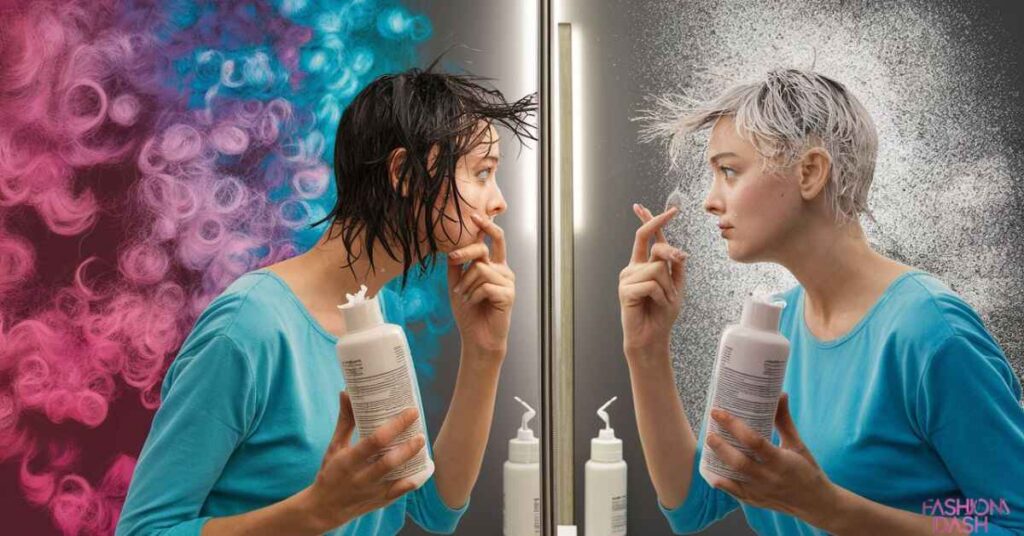
Now that you understand the differences between bleaching wet and dry hair, as well as the proper preparation and aftercare, let’s address the million-dollar question: should you bleach wet or damp hair?
The general consensus among professional stylists is that bleaching dry hair is the safest and most controlled approach. However, there are certain situations where bleaching damp hair may be appropriate or even preferred.
- Balayage Highlights: This technique involves hand-painting the bleach onto the surface of the hair. Working with slightly damp strands can make the application smoother and more seamless.
- Root Touch-ups: If you’re simply refreshing your roots, applying bleach to slightly damp, unwashed hair can be easier and more precise.
- Toning or Glossing: These semi-permanent color treatments can often be applied safely to damp hair without causing excessive damage.
If you’re attempting a full head of bleach or a dramatic color change, it’s generally better to start with clean, dry hair. This gives you more control over the process and reduces the risk of uneven results or damage.
However, if you’re an experienced bleacher or working with a professional stylist, bleaching damp hair may be an option in certain cases. Just be sure to follow all safety precautions and product instructions carefully.
No matter which approaches you choose, remember that bleaching is a harsh chemical process that can take a toll on your hair. Always prioritize the health of your strands and be prepared to invest in quality aftercare products and treatments.
With the right knowledge, preparation, and technique, you can achieve stunning, vibrant results while minimizing damage and keeping your hair looking and feeling its best.
Real-Life Examples and Case Studies
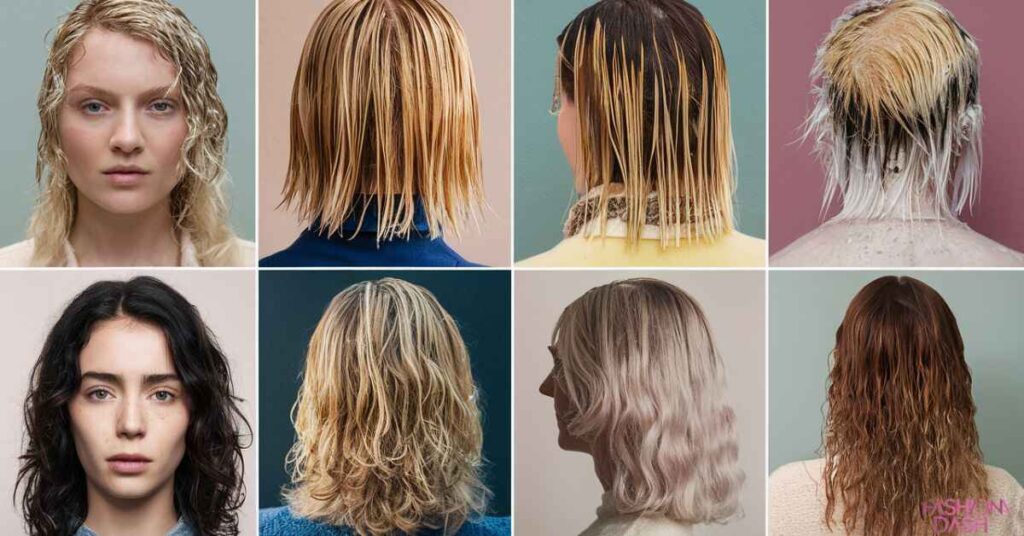
Sometimes it’s helpful to see real-life examples of bleaching wet vs dry hair. Here are a few case studies to illustrate the differences.
Case Study 1: Balayage on Damp Hair Sarah wanted to add some sun-kissed balayage highlights to her brunette locks. Her stylist recommended bleaching slightly damp hair for this technique. By working on damp strands, the stylist could more easily hand-paint the bleach onto the surface of Sarah’s hair, creating a beautiful, blended effect.
Case Study 2: Full Head of Highlights on Dry Hair After years of being a brunette, Ashley was ready for a drastic change to bright blonde. Her stylist insisted on bleaching her hair when it was completely dry and free of any product buildup. This allowed for even, precise application of the bleach from roots to ends, resulting in a gorgeous, multi-dimensional blonde shade with minimal damage.
Case Study 3: Root Touch-Up on Slightly Damp Hair As a busy working mom, Carly didn’t always have time for a full color session. For quick root touch-ups every 6-8 weeks, her stylist would apply the bleach to her slightly damp, unwashed roots. This made the application easier and more seamless, while still maintaining Carly’s beautiful blonde shade.
As you can see, the decision to bleach wet or dry hair often depends on the specific technique, desired result, and the stylist’s professional recommendation.
Quotes from Haircare Experts
Don’t just take our word for it! Here’s what some top haircare experts have to say about bleaching wet vs dry hair.
Bleaching wet hair can lead to uneven coverage and excessive damage. I always recommend starting with clean, dry strands for the most controlled and precise application.
- Jen Atkin, Celebrity Hairstylist
For techniques like balayage or ombre, working on slightly damp hair can actually be beneficial. The moisture helps the bleach adhere smoothly to the surface.
- Justine Marjan, Tiresome Global Stylist
The state of your hair plays a huge role in the outcome of any color service. Wet hair is more porous, so the bleach can penetrate deeper, leading to potential breakage.
- Cassondra Kaeding, Hairstylist and Colorist
As these experts highlight, the decision to bleach wet or dry hair is nuanced and depends on various factors, including the desired result and specific technique being used.
Stunning Blonde Inspiration
Now that you understand the ins and outs of bleaching wet vs dry hair, let’s provide some inspiration for gorgeous blonde hues you can achieve:
Platinum Blonde This icy, almost white-blonde shade is a major statement. To nail this look, you’ll likely need to bleach your hair to the palest level of blonde.
Honey Blonde For a warm, sun-kissed vibe, try a beautiful honey blonde with dimensional golden highlights.
Strawberry Blonde This reddish-blonde tone is perfect for those who want a unique twist on the classic blonde.
Rooted Blonde Create a seamless, low-maintenance look by leaving your roots their natural shade and blending them into bright blonde ends.
Chunky Highlights Add depth and dimension with bold, face-framing chunky highlights against a darker blonde base.
The options are endless when it comes to stunning blonde looks! With proper preparation, application, and aftercare, you can rock vibrant, healthy blonde locks.
Remember, achieving and maintaining your dream blonde often requires touch-ups every 6-8 weeks to keep your color fresh and your roots blended. But the gorgeous results are well worth the effort.
Frequently Asked Question
Can I bleach my hair when it’s wet?
You can, but it’s generally riskier than bleaching dry hair. Wet hair is more porous, so the bleach can cause excessive damage.
Is it better to bleach hair wet or dry?
Most stylists recommend bleaching clean, dry hair for even coverage and better control. However, some techniques like balayage can be done on slightly damp hair.
Can I apply toner to wet hair after bleaching?
Yes, toners and glosses can often be applied to damp hair after bleaching without causing too much additional damage.
How do I prep my hair for bleaching?
Do a strand test first. Deep condition a few days before, and apply a barrier cream like Vaseline around your hairline.
How can I minimize damage when bleaching wet hair?
Use a bond rebuilding treatment and minimize processing time. Deep condition regularly after bleaching wet hair.
How soon can I wash my hair after bleaching wet?
Wait at least 24-48 hours before shampooing hair after bleaching to allow the cuticle to reseal and lock in the new blonde tone.
Conclusion
bleaching hair wet or dry ultimately comes down to your desired results and specific hair situation. While bleaching dry hair is generally considered the safest approach for even, controlled lightening, there are certain techniques like balayage highlights or root touch-ups were working on slightly damp strands may be preferred.
Regardless of whether you choose to bleach wet or dry, proper preparation, following instructions diligently, and investing in quality aftercare products are absolutely essential for maintaining healthy, vibrant blonde locks. If you’re ever unsure, don’t hesitate to consult with a professional stylist to guide you through the process and achieve your dream shade without compromising the integrity of your hair.
With the right knowledge and care, you can rock stunning blonde hues while keeping your tresses looking and feeling their absolute best.
